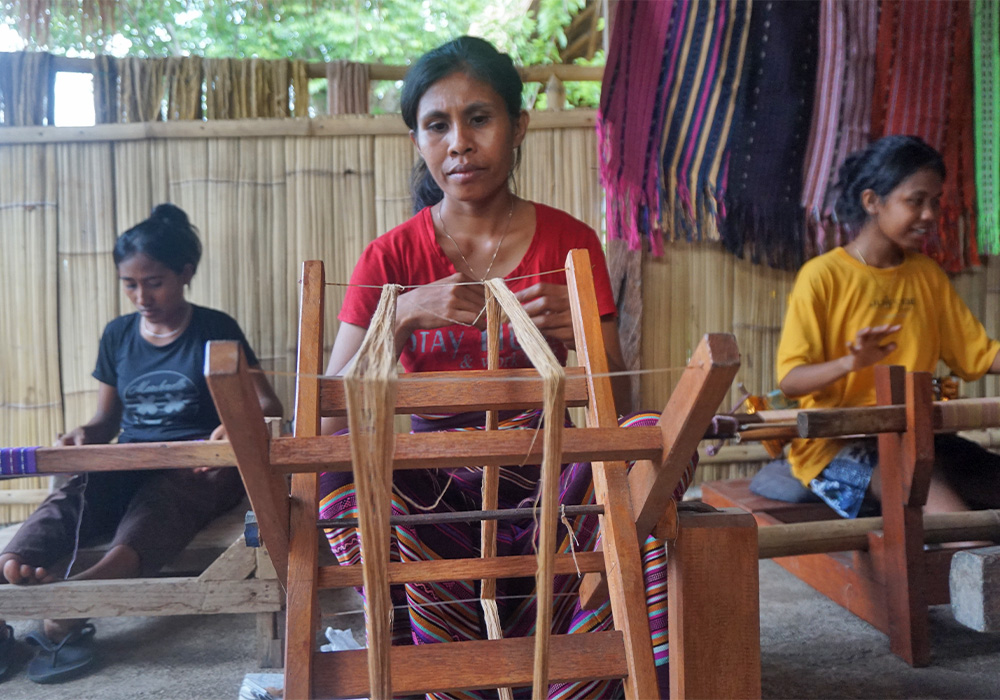
Mariana Tuto demonstrates traditional ikat weaving at her studio, Rumah Tenun Milenial, located in Desa Gayak, Ile Boleng, Flores Timur, Nusa Tenggara Timur. (Shinta Maharani)
- admin
- 03 June 2024
- Feature
The Fight Of Youth For Tradition, Weaving, And Environment Protection
Mariana Tuto Demon, more known to her peers as Ria, strives to protect the cultural heritage passed down by her ancestors, and protect the environment through the promotion of their community’s traditions on weaving.
Ria comes from the Lamaholot People in Nusa Tenggara Timur, a province renowned for its traditional ikat weaving crafts that have been nurtured and evolved across generations. Some of the popular ikat weaving crafts are from the Lamaholot. The Lamaholot is an ethnic group that resides in the East Flores Regency and Lembata Regency of East Nusa Tenggara, Indonesia. They are spread across various islands such as Flores Island, Adonara Island, Solor Island, and Lembata Island, in the eastern part of the province.
Ria inherited the art of weaving from her family. Almost all the women in her village are skilled at weaving, especially the art of Ikat, which holds high value for the women in East Flores.
“The tradition of weaving has been passed down from generation to generation and it has become a routine activity,” she said. “Ikat woven fabric is not only a symbol of tradition but also holds cultural significance. When there is a death ceremony, women are required to wear tenun or ikat weaving.”
Ria established the Rumah Tenun Milenial, a weaving hut with a thatched roof and wooden walls, in 2022. She gathered young people in her village, most of them still in high school, and taught them to weave.
Ria's mission is to train young people to weave quality ikat so that they have jobs in the village and are not forced to work as migrant workers. Apart from that, she wants to continue the Lamaholot weaving tradition.
"In East Flores, most young people are high school graduates and aspire to work outside NTT,” she said. “The lack of job opportunities forces them to migrate, and I have a mission to train young people to weave so that they have jobs in their villages and are not forced to work as migrant workers."
Over time, Ria has increased the number of young people she trains from 8 to 85. She teaches students from the four villages of Nobo, Poleng, Gayak, and Kelu. These four villages are known for their ikat weaving. Every Saturday, Ria goes to Kelu village and weaves with the young people in the hall of the former sub-district office.
Ria observed the growing trend among the young generation to wear weaves. Ria started to feel overwhelmed by the demand for weaving. To meet the demand, she buys weaving produced in the village weaving centers. Ria then resells these products in her shop. She relies on social media - Facebook, TikTok, and Instagram - to market the weaving produced by Rumah Tenun Milenial.
"Ikat weaving is sold using a reseller system in 134 regions, including Batam and Papua,” she said. “There are also those selling in Sabah, Malaysia. Consumers are mostly young people who know them through Facebook, Instagram, and TikTok."
The youth who join the Millennial Weaving House need continuous capacity building in knowledge and skills. To do this, they must also engage in platforms where there is knowledge exchange. Ria and one of her students, Anjelina, who has been actively weaving since graduating from high school, participated in a forum that brought together women from eight Southeast Asian countries on 20-26 May 2023.
The Samdhana Institute held the Southeast Asia Women Environmental Human Rights Defenders (WEHRDs) Summit 2023 in Pajinian Village. This was a meeting of women defenders of human rights and the environment. They discussed ecosystem protection, food security, sovereignty, and recognizing and protecting people's rights.
Eco-friendly Weaving Product
Ria also had the opportunity to take part in an organizational management training in Sumba for two weeks in July 2023. The training was about business that creates social value, and about marketing so that natural dye weaving can enter the international market.
Instead of using only synthetic dyes, Rumah Tenun Milenial gives value to natural dyes. The Lamaholot tribe uses natural colors from plants. The blue color is obtained from indigo leaves or Indigofera tinctoria. The maroon color is from noni, the yellow is from turmeric, and the white is from sweet potato flour. Weaving with natural dyes is more expensive than weaving with synthetic dyes because the process of dyeing the fibers is more complicated and takes longer.
In December 2023, she received support from the Samdhana Institute to organize a training in traditional textile arts to increase the value of weaving, and weaving using natural dyes. The need to use natural dyes is increasing. This would mean that there will be more plants, the source of these dyes, which will also increase vegetation cover in these weaving communities.
This maintains a natural balance between the use and protection of the environment.
The presence of the Millennial Weaving House is not only a home for women and young people to learn from each other but it has also made Lamaholot weaving a symbol of a movement for environmental protection.